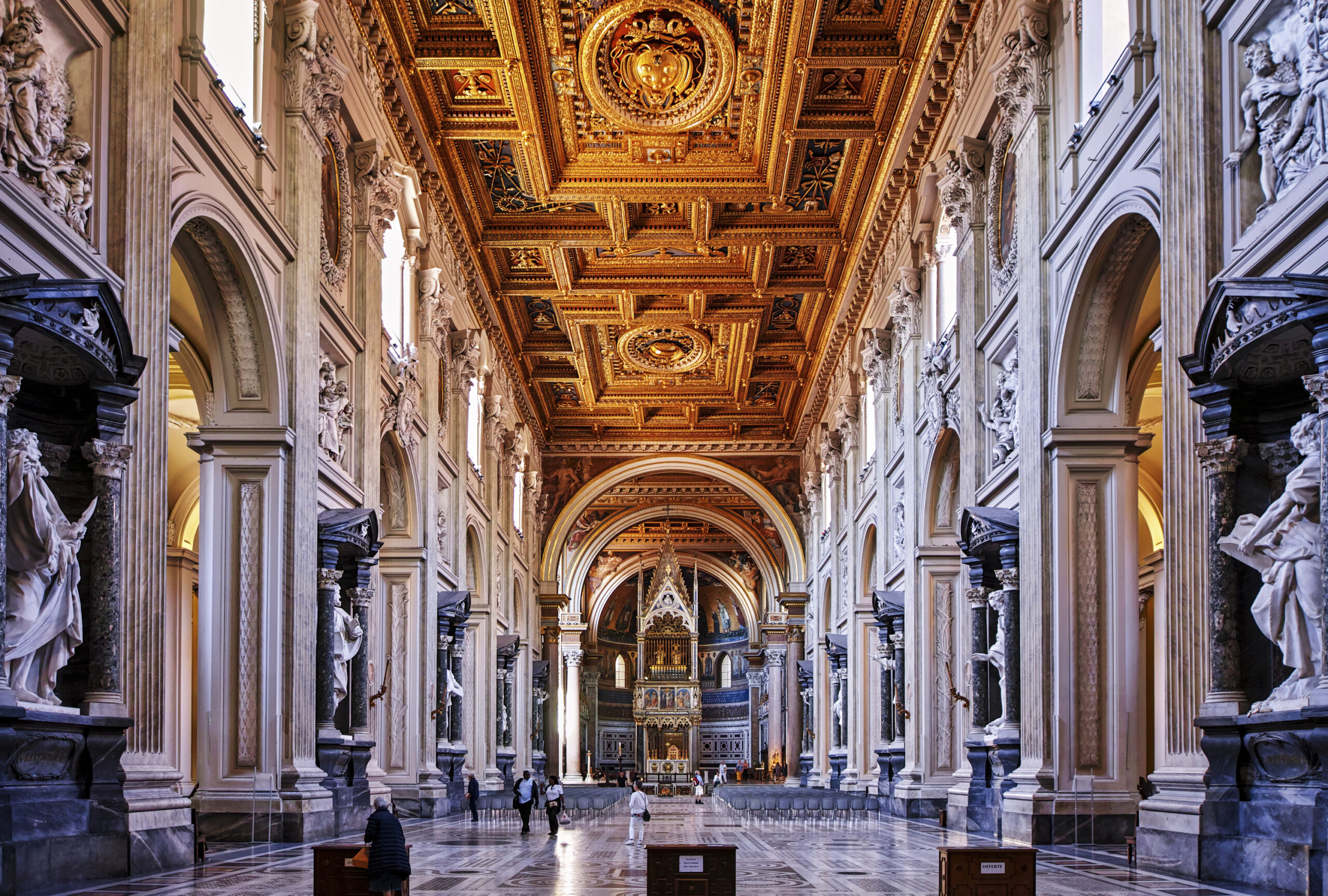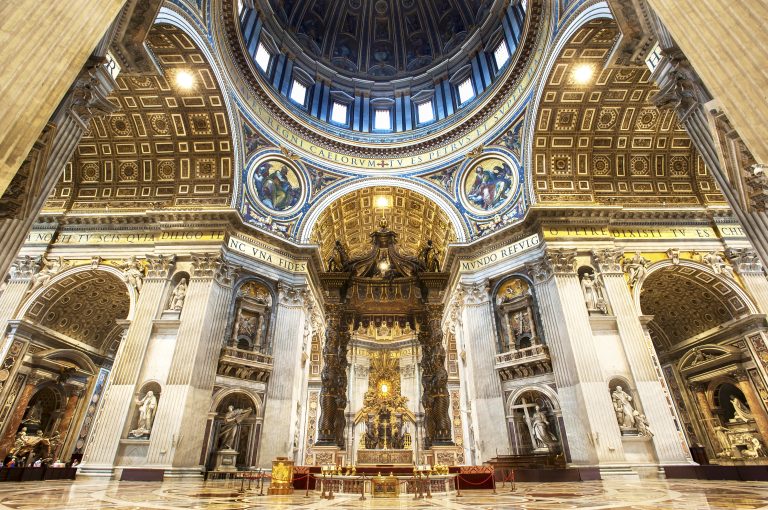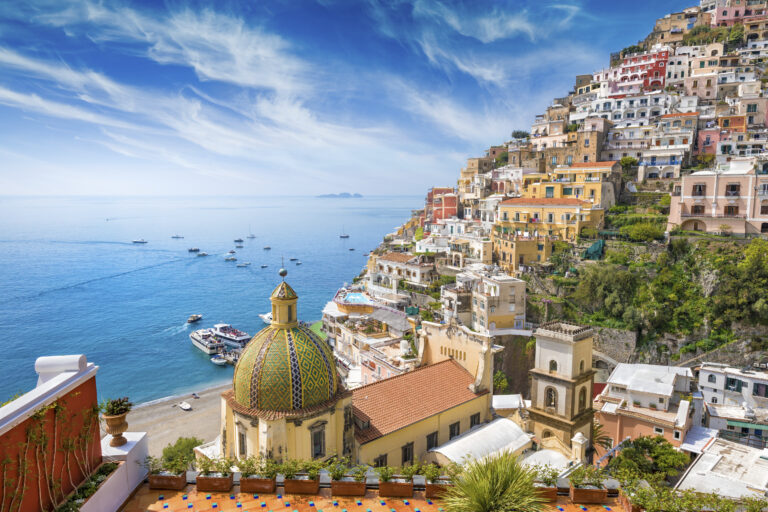
Visiting the Archbasilica of St. John Lateran in Rome: All you need to know
The Archbasilica of St. John Lateran, the cathedral of the Pope and one of the four major basilicas in Rome, is a must-see for history and architecture enthusiasts. It is not only the oldest basilica in the city, but also the seat of the Bishop of Rome. Known for its impressive Baroque facade and interior adorned with mosaics, it embodies the spiritual heart of Christianity. Visiting this iconic place is to dive into nearly two millennia of faith, power and sacred art.
Discover all you need to know for a memorable visit to the Archbasilica of St. John Lateran.
- What works of art are must-sees inside the Archbasilica of St. John Lateran in Rome?
- Where can I book my visit to the Archbasilica of St. John Lateran in Rome?
- How long should I plan for a visit to the Archbasilica of St. John Lateran in Rome?
- What is the best time to visit the Archbasilica of St. John Lateran to avoid crowds?
- How can I attend Mass at the Archbasilica of St. John Lateran?
- Are there guided tours available to learn more about the history and architecture of the basilica?
- What are the main other sites to visit around the Archbasilica of St. John Lateran in Rome?
What works of art are must-sees inside the Archbasilica of St. John Lateran in Rome?
Here are the 7 must-see works of art to discover inside the Archbasilica of St. John Lateran in Rome:
- The Papal Altar: This is the ceremonial center of the basilica, often associated with papal celebrations. This magnificent Baroque altar, built by the Italian architect Alessandro Galilei in the 18th century, is richly decorated with sculptures and mosaics.
- The Chair of St. Bernin: This pulpit sculpted by Giovanni Lorenzo Bernini in the 17th century is a masterpiece of Baroque art. It is adorned with statues of the four evangelists (Matthew, Mark, Luke, and John) and other complex sculpted details. It is considered a masterpiece of Baroque art and a dazzling example of Bernini's genius in sculpture.
- The Triumph Mosaics: Located in the apse of the basilica, these mosaics date back to the 12th century. They depict Christ in Majesty, surrounded by the apostles Peter and Paul, with scenes from the Last Judgment and celestial figures. These mosaics are an important example of Byzantine art and how it influenced Christian art in the West.
- The Statues of the Apostles: Twelve large marble statues, representing the apostles, are arranged in niches along the walls of the basilica. They date from the 13th century and are attributed to medieval artists.
- The Christ Pantocrator: This 13th-century mosaic is located in the tympanum above the central door. It shows Christ in Majesty, with symbols of power and divinity. It is an important example of the iconographic representation of Christ and illustrates the influence of Byzantine art in medieval Christian art.
- The Frescoes of the Chapel of Saint-Sylvestre: These frescoes, painted by Giovanni Battista Salvi da Sassoferrato in the 17th century, illustrate scenes from the life of Saint-Sylvestre, Pope of the 4th century. They are a testament to the religious art of the Baroque period and offer a glimpse of the important events in the life of Saint-Sylvestre.
- The Relics and Sculptures of the Basilica's Treasury: The basilica's treasury contains a precious collection of relics, such as fragments of the True Cross, and ancient sculptures, such as bas-reliefs and statues.
Did you know? The Basilica houses many relics. Notably, the top of a table that is said to be the one of the Last Supper, in the North transept, above the columns of the Temple of Jupiter Capitolin. Also the heads of Saint Peter and Saint Paul of Tarsus transferred on March 2, 1370 by Pope Urban V in the ciborium of the basilica.
These works of art offer a glimpse into the evolution of Christian art over the centuries and the religious importance of the Archbasilica of St. John Lateran.
Discover the Archbasilica of St. John Lateran in Rome in our interactive Tripwizy Guide
Where can I book my visit to the Archbasilica of St. John Lateran in Rome?
Visiting the Archbasilica of St. John Lateran is free, but tickets may be required for certain sections or for a guided tour. You can book these tickets online on the Tripwizy page for the Archbasilica of St. John Lateran.
How long should I plan for a visit to the Archbasilica of St. John Lateran in Rome?
It is recommended to plan about 1 to 2 hours for a visit to the Archbasilica of St. John Lateran. This time will allow you to discover the inside of the basilica, admire its works of art, such as the mosaics and statues, and explore the main attractions such as the papal altar and the Chair of St. Bernin. If you want to deepen your visit or participate in a guided tour, plan a little more time. Also be sure to check the visiting hours on the Tripwizy page for the Archbasilica of St. John Lateran to avoid unforeseen closures.
What is the best time to visit the Archbasilica of St. John Lateran to avoid crowds?
To avoid crowds at the Archbasilica of St. John Lateran, it's best to visit early in the morning, just at opening, or in the middle of the afternoon, after the tourist peak hours. Weekdays are generally less busy than weekends. Holiday periods and public holidays can attract more visitors, so plan your visit outside of these times if possible. Also avoid days when special events or papal ceremonies are scheduled.
How can I attend Mass at the Archbasilica of St. John Lateran?
To attend Mass at the Archbasilica of St. John Lateran, you need to check the official event calendar. Important masses at the basilica are often celebrated by the Pope or other high dignitaries. It is recommended to inquire at the office of the Archdiocese of Rome or consult the official website of the basilica for times and how to register or obtain tickets, if necessary.
Are there guided tours available to learn more about the history and architecture of the basilica?
Yes, guided tours are available to discover the history and architecture of the Archbasilica of St. John Lateran. You can book these tours in advance online by looking at our selection of activities for the Archbasilica of St. John Lateran. These tours are often offered in several languages and offer an in-depth look at the historical, architectural and artistic aspects of the basilica.
What are the main other sites to visit around the Archbasilica of St. John Lateran in Rome?
Around the Archbasilica of St. John Lateran in Rome, several sites of interest are worth visiting:
- The Basilica of St. Mary Major: Another great Roman basilica, famous for its 5th century mosaics and its impressive gilded wooden ceiling (10 minutes walk).
- The Baths of Caracalla: Impressive ruins of an ancient Roman bath complex, offering a glimpse into the grandeur of Roman architecture (20 minutes walk).
- The Arch of Constantine: A triumphal arch dating from the early 4th century, dedicated to Emperor Constantine, located near the Colosseum (20 minutes walk)
- The Colosseum: The famous Roman amphitheater, iconic of antiquity, known for its gladiatorial combats and other spectacles (20 minutes walk)
- The Circus Maximus: A vast chariot racing site in antiquity, now a large park with archaeological remains (15 minutes walk)
- The Roman Forum: An archaeological complex including the ruins of several important temples and government buildings from ancient Rome (20 minutes walk)
Did you know? Opposite the Basilica, the obelisk of St. John Lateran is the oldest and largest obelisk from Egypt in Rome, dating back to the reign of the pharaohs Thutmose III and Thutmose IV. It was brought to Rome under Emperor Constantine.
These sites offer a rich historical and cultural experience and are easily accessible from the Archbasilica of St. John Lateran.
Discover the Archbasilica of St. John Lateran in Rome in our interactive Tripwizy Guide
We would be delighted to hear your thoughts on the Archbasilica of St. John Lateran. Share your experiences, highlights, and tips for other visitors. Whether you are moved by the architecture, the spiritual atmosphere or the artistic treasures, your comments will enrich the community of Rome enthusiasts.
To deepen your discovery of the major basilicas of Rome, consult our page dedicated to the four major basilicas and discover the importance of the Jubilee 2025. These events and sacred places are essential stops for visitors seeking history and spirituality.



